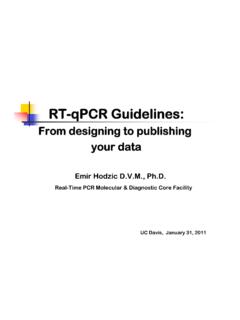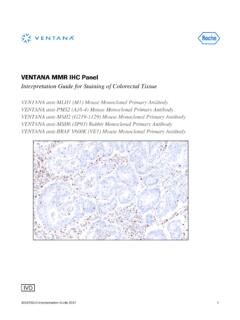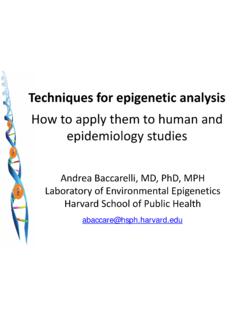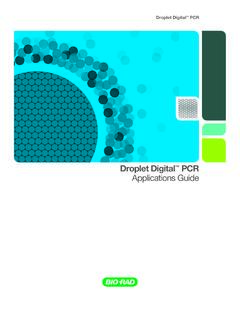Transcription of FoundationOne CDx Intended Use Table 1 - Foundation …
1 Page 1 of 80 RAL-0003-16 FoundationOne CDx Technical Information Foundation Medicine, Inc. 150 Second Street, Cambridge, MA 02141 Phone: Intended Use FoundationOne CDx (F1 CDx) is a qualitative next-generation sequencing based in vitro diagnostic test that uses targeted high throughput hybridization-based capture technology for detection of substitutions, insertion and deletion alterations (indels), and copy number alterations (CNAs) in 324 genes and select gene rearrangements, as well as genomic signatures including microsatellite instability (MSI) and tumor mutational burden (TMB) using DNA isolated from formalin- fixed , paraffin - embedded ( ffpe ) tumor tissue specimens. The test is Intended as a companion diagnostic to identify patients who may benefit from treatment with the targeted therapies listed in Table 1 in accordance with the approved therapeutic product labeling.
2 Additionally, F1 CDx is Intended to provide tumor mutation profiling to be used by qualified health care professionals in accordance with professional guidelines in oncology for patients with solid malignant neoplasms. Genomic findings other than those listed in Table 1 are not prescriptive or conclusive for labeled use of any specific therapeutic product. Table 1. Companion diagnostic indications Tumor Type Biomarker(s) Detected Therapy Non-small cell lung cancer (NSCLC) EGFR exon 19 deletions and EGFR exon 21 L858R alterations EGFR Tyrosine Kinase Inhibitors (TKI) approved by FDA* EGFR exon 20 T790M alterations Tagrisso (osimertinib) ALK rearrangements Alecensa (alectinib), Alunbrig (brigatinib) Xalkori (crizotinib), or Zykadia (ceritinib) BRAF V600E Tafinlar (dabrafenib) in combination with Mekinist (trametinib) MET single nucleotide variants (SNVs) and indels that lead to MET exon 14 skipping Tabrecta (capmatinib) Melanoma BRAF V600E BRAF Inhibitors approved by FDA* BRAF V600E and V600K Mekinist (trametinib) or BRAF/MEK Inhibitor Combinations approved by FDA* BRAF V600 mutation-positive Tecentriq (atezolizumab) in combination with Cotellic (cobimetinib) and Zelboraf (vemurafenib)
3 Page 2 of 80 RAL-0003-16 Breast cancer ERBB2 (HER2) amplification Herceptin (trastuzumab), Kadcyla (ado-trastuzumab-emtansine), or Perjeta (pertuzumab) PIK3CA C420R, E542K, E545A, E545D [1635G>T only], E545G, E545K, Q546E, Q546R, H1047L, H1047R, and H1047Y alterations Piqray (alpelisib) Colorectal cancer KRAS wild-type (absence of mutations in codons 12 and 13) Erbitux (cetuximab) KRAS wild-type (absence of mutations in exons 2, 3, and 4) and NRAS wild type (absence of mutations in exons 2, 3, and 4) Vectibix (panitumumab) Ovarian cancer BRCA1/2 alterations Lynparza (olaparib) or Rubraca (rucaparib) Cholangiocarcinoma FGFR2 fusions and select rearrangements Pemazyre (pemigatinib) or Truseltiq (infigratinib) Prostate cancer Homologous Recombination Repair (HRR) gene (BRCA1, BRCA2, ATM, BARD1, BRIP1, CDK12, CHEK1, CHEK2, FANCL, PALB2, RAD51B, RAD51C, RAD51D and RAD54L) alterations Lynparza (olaparib) Solid tumors MSI-High Keytruda (pembrolizumab) TMB 10 mutations per megabase Keytruda (pembrolizumab) NTRK1/2/3 fusions Vitrakvi (larotrectinib) *For the most current information about the therapeutic products in this group, go to: The test is also used for detection of genomic loss of heterozygosity (LOH) from formalin- fixed , paraffin - embedded ( ffpe ) ovarian tumor tissue.
4 Positive homologous recombination deficiency (HRD) status (F1 CDx HRD defined as tBRCA-positive and/or LOH high) in ovarian cancer patients is associated with improved progression-free survival (PFS) from Rubraca (rucaparib) maintenance therapy in accordance with the Rubraca product label. The F1 CDx assay is performed at Foundation Medicine, Inc. sites located in Cambridge, MA and Morrisville, NC. Contraindication There are no known contraindications. Warnings and Precautions Alterations reported may include somatic (not inherited) or germline (inherited) alterations; however, the test does not distinguish between germline and somatic alterations. The test does not provide information about susceptibility. Biopsy may pose a risk to the patient when archival tissue is not available for use with the assay. The patient s physician should determine whether the patient is a candidate for biopsy.
5 Page 3 of 80 RAL-0003-16 Reflex testing to an alternative FDA approved companion diagnostic should be performed for patients who have an ERBB2 amplification result detected with copy number equal to 4 (baseline ploidy of tumor +2) for confirmatory testing. While this result is considered negative by F1 CDx, in a clinical concordance study with an FDA approved FISH test, 70% (7 out of 10 samples ) were positive, and 30% (3 out 10 samples ) were negative by the FISH test with an average ratio of The frequency of ERBB2 copy number 4 in breast cancer is estimated to be approximately 2%1. 1 Multiple references listed in ) report the frequency of HER2 overexpression as 20% in breast cancer. Based on the F1 CDx HER2 CDx concordance study, approximately 10% of HER2 amplified samples had copy number 4. Thus, total frequency is conservatively estimated to be approximately 2%.
6 Limitations For in vitro diagnostic use. For prescription use only. This test must be ordered by a qualified medical professional in accordance with clinical laboratory regulations. A negative result does not rule out the presence of a mutation below the limits of detection of the assay. samples with <25% tumor may have decreased sensitivity for the detection of CNAs including ERBB2. Clinical performance of Tagrisso (osimertinib) in patients with an EGFR exon 20 T790M mutation detected with an allele fraction <5% is ongoing and has not been established. Concordance with other validated methods for CNA (with the exception of ERBB2 amplifications and BRCA1/2 homozygous deletions) and gene rearrangement (with the exception of ALK) detection has not been demonstrated and will be provided in the post-market setting. Confirmatory testing using a clinically validated assay should be performed for all CNAs and rearrangements not associated with CDx claims noted in Table 1 of the Intended Use, but used for clinical decision making.
7 For patients with solid tumors whose samples have MSI scores > and < , an MSI Cannot Be Determined result is reported. Patients with this result should be re-tested with a validated orthogonal (alternative) method as these MSI scores represent a range of scores with low reliability. The likelihood of a patient receiving this result is ~ within solid tumors. Patients with solid tumors may also receive an MSI status reported as Cannot Be Determined due to a quality control (QC) failure. When all sample-level quality metrics are met, the rate of MSI Cannot Be Determined results due to a QC failure is Patients with this result should consider re-testing with FoundationOne CDx or an orthogonal (alternative) method, if clinically appropriate. TMB by F1 CDx is determined by counting all synonymous and non-synonymous variants present at 5% allele frequency or greater (after filtering) and the total number is reported as mutations per megabase (mut/Mb) unit.
8 Observed TMB is dependent on characteristics of the specific tumor focus tested for a patient ( , primary vs. metastatic, tumor content) and the testing platform used for the detection; therefore, observed TMB results may vary between different specimens for the same patient and between detection methodologies employed on the same sample. The TMB calculation may differ from TMB calculations used by other assays depending on variables such as the amount of genome interrogated, percentage of tumor, assay limit of detection (LoD), filtering of alterations included in the score, and the read depth and other bioinformatic test specifications. Refer to the SSED for a detailed description of these variables in FMI s TMB calculation The clinical validity of TMB defined by this panel has been established for TMB as a qualitative output for a cut-off of 10 mutations per megabase but has not been established for TMB as a quantitative score.
9 Decisions on patient care and treatment must be based on the independent medical judgment of the treating physician, taking into consideration all applicable information concerning the patient s condition, such as patient and family history, physical examinations, information from other diagnostic tests, and patient preferences, in accordance with the standard of care in a given community. The test is Intended to be performed on specific serial number-controlled instruments by Foundation Medicine, Inc. Alterations in polyT homopolymer runs may not be reliably detected in BRCA1/2. Page 4 of 80 RAL-0003-16 Certain large rearrangements in BRCA1/2 including large scale genomic deletions (affecting at least one whole exon), insertions or other deleterious genomic rearrangements including inversions or transversion events, may not be detected in an estimated 5% of ovarian cancer patients with BRCA1/2 mutations by F1 CDx.
10 Certain potentially deleterious missense or small in-frame deletions in BRCA1/2 may not be reported under the CDx associated findings but may be reported in the Other alterations and biomarkers identified section in the patient report. Alterations at allele frequencies below the established limit of detection may not be detected consistently. Detection of LOH has been verified only for ovarian cancer patients Performance of the LOH classification has not been established for samples below 35% tumor content and with LOH scores near the cut-off of 16. There may be potential interference of ethanol with LOH detection. The interfering effects of xylene, hemoglobin, and triglycerides on the LOH score have not been demonstrated. While the overall positive percent agreement between trial enrollment assays and F1 CDx was 84% (37/44), thirty percent (30%) (6/20) of patients enrolled in the VITRAKVI clinical studies using RNA-based NGS detection were negative for NTRK fusions by F1 CDx.







